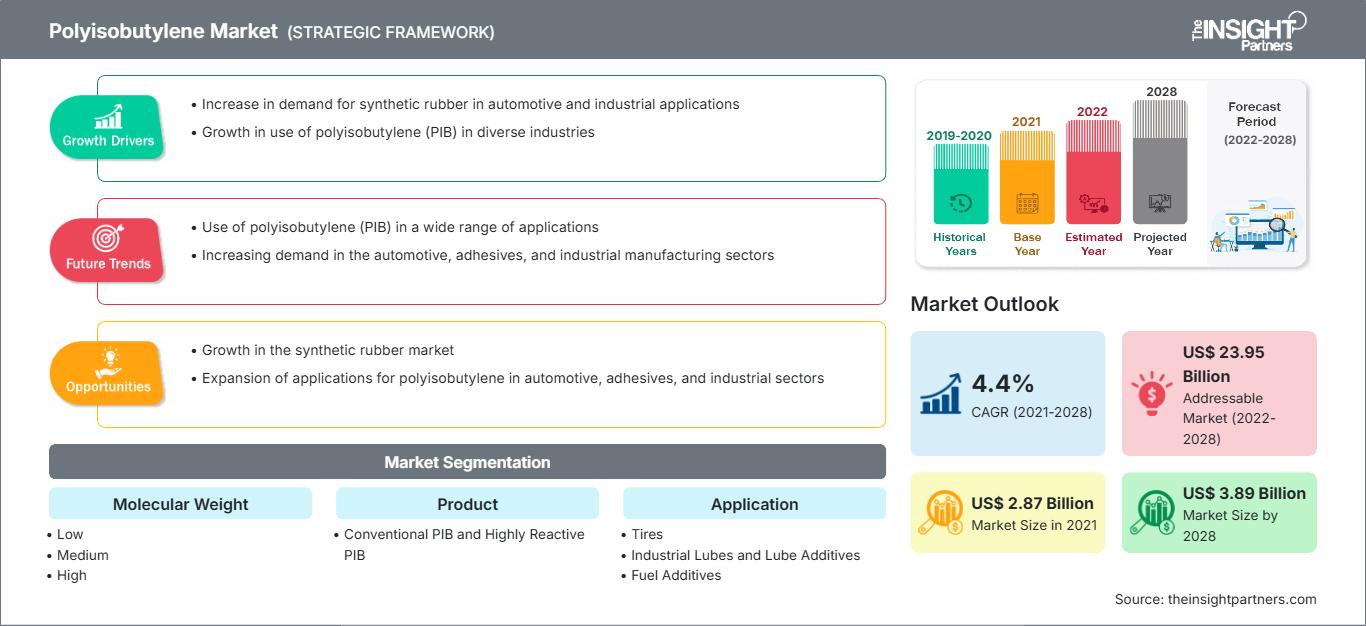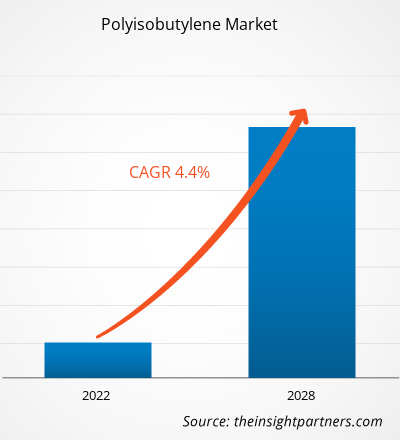[연구 보고서] 폴리이소부틸렌 시장은 2021년 28억 7,114만 달러 규모였으며, 2028년에는 38억 9,116만 달러에 이를 것으로 예상되며, 2021년부터 2028년까지 연평균 4.4% 성장할 것으로 예상됩니다.
폴리이소부틸렌(PIB)은 엘라스토머 또는 합성 고무입니다. 분자량에 따라 시장은 저분자량, 중분자량, 고분자량으로 구분됩니다. 다용도로 사용 가능하며 무독성이고 무색투명한 점성 액체입니다. 폴리이소부틸렌은 점착성을 높이고, 발수성을 제공하며, 점도 지수를 개선하고, 우수한 전기 절연성을 제공합니다. 2020년 북미 지역은 세계 폴리이소부틸렌 시장에서 가장 큰 매출 점유율을 기록했습니다. 운송, 농약, 전기, 접착제 등 다양한 응용 분야의 수요 증가가 북미 시장 성장을 견인하고 있습니다. 폴리이소부틸렌은 낮은 가스 투과성, 뛰어난 인장 강도, 높은 내화학성, 높은 강성을 제공하기 때문에 운송, 식품 및 건설 산업에서 점점 더 많이 사용되고 있습니다.
이 보고서의 일부, 국가 수준 분석, Excel 데이터 팩을 포함하여 모든 보고서에 대한 사용자 정의를 무료로 받을 수 있을 뿐만 아니라 스타트업 및 대학을 위한 훌륭한 제안 및 할인을 이용할 수 있습니다
폴리이소부틸렌 시장: 전략적 통찰력

-
이 보고서의 주요 주요 시장 동향을 확인하세요.이 무료 샘플에는 시장 동향부터 추정 및 예측에 이르기까지 데이터 분석이 포함됩니다.
COVID-19 팬데믹이 폴리이소부틸렌 시장에 미치는 영향
COVID-19 팬데믹은 화학 및 소재 부문의 상황을 크게 변화시켰고, 폴리이소부틸렌 시장 성장에 부정적인 영향을 미쳤습니다.
글로벌 화학 및 소재 산업은 공급망 붕괴, 기술 행사 취소, 사무실 폐쇄 등 팬데믹으로 인한 심각한 차질을 겪고 있는 주요 산업 중 하나입니다. 유럽, 아시아, 북미 국가들이 시행한 전 세계 여행 금지 조치는 기업 협력 및 파트너십 기회에 영향을 미치고 있습니다. 이러한 모든 요인은 전자 및 화학 및 소재 산업에 부정적인 영향을 미쳐 관련 산업의 다양한 시장 성장을 저해할 것으로 예상됩니다. 그러나 각국이 사업 재개를 계획함에 따라 폴리이소부틸렌 수요는 전 세계적으로 증가할 것으로 예상됩니다. 전 세계적으로 사업 활동이 재개되고 봉쇄 조치가 해제됨에 따라 하류 산업인 산업용 윤활유 및 윤활 첨가제 부문의 폴리이소부틸렌 수요도 증가하기 시작했습니다. 시장 통찰력: 자동차 산업, 예측 기간 동안 시장 성장 촉진자동차 산업에 있어 엔진의 일상적인 기능 수행 성능은 매우 중요합니다. 자동차 산업은 오랫동안 여러 유형의 연료 첨가제의 주요 시장이었습니다. 효율적인 화석 연료 대체재 부족과 중산층 경제 성장으로 인해 자동차 연료 첨가제 시장 점유율은 다른 연료 첨가제 시장 부문보다 지속적으로 높았습니다. 최근 몇 년 동안 항공 연료 첨가제의 상대적 중요성이 커지면서 폴리이소부틸렌 수요가 급증했습니다.
응용 분야 통찰력
전 세계 폴리이소부틸렌 시장은 용도별로 타이어, 산업용 윤활유 및 윤활 첨가제, 연료 첨가제, 접착제 및 실란트 등으로 세분화됩니다. 산업용 윤활유 및 윤활 첨가제 부문은 2020년 시장 점유율 1위를 차지했습니다. 폴리이소부틸렌(PIB)은 말레산 무수물과 반응하여 폴리이소부테닐숙신산 무수물(PIBSA)을 형성하는데, 이는 윤활유 분산제와 연료 세제의 기본 구성 요소입니다. 폴리이소부틸렌(PIB)에서 파생된 또 다른 변종인 폴리이소부틸렌숙신이미드(PIBSI)는 수용성 금속 가공 유체에서 산화방지제 유화제 및 윤활 첨가제 구성 요소로 작용합니다. PIB는 연소 세정력도 뛰어나 대형 디젤 엔진에서 발생하는 강한 블로바이 가스에 노출되는 2행정 엔진 오일 및 선박용 윤활제에 사용하기에 이상적입니다.
BASF SE, Braskem SA, 대림산업 석유화학 사업부, Ineos AG, Infineum International Limited., Kothari Petrochemicals., Sibur Holding PJSC, Kemat Polybutenes, The Lubrizol Corporation, 그리고 TPC Group은 글로벌 폴리이소부틸렌 시장의 주요 기업입니다. 이 시장에서 활동하는 기업들은 고객의 요구를 충족하는 고품질의 혁신적인 제품 개발에 집중하고 있습니다.
폴리이소부틸렌
폴리이소부틸렌 시장 지역별 통찰력
The Insight Partners의 분석가들은 예측 기간 동안 폴리이소부틸렌 시장에 영향을 미치는 지역별 동향과 요인들을 면밀히 분석했습니다. 이 섹션에서는 북미, 유럽, 아시아 태평양, 중동 및 아프리카, 그리고 중남미 지역의 폴리이소부틸렌 시장 부문 및 지역별 현황도 다룹니다.
폴리이소부틸렌 시장 보고서 범위
| 보고서 속성 | 세부 |
|---|---|
| 시장 규모 2021 | US$ 2.87 Billion |
| 시장규모별 2028 | US$ 3.89 Billion |
| 글로벌 CAGR (2021 - 2028) | 4.4% |
| 이전 데이터 | 2019-2020 |
| 예측 기간 | 2022-2028 |
| 다루는 세그먼트 |
By 분자량
|
| 포함된 지역 및 국가 |
북미
|
| 시장 선도 기업 및 주요 회사 프로필 |
|
폴리이소부틸렌 시장 참여자 밀도: 비즈니스 역학에 미치는 영향 이해
폴리이소부틸렌 시장은 소비자 선호도 변화, 기술 발전, 그리고 제품의 이점에 대한 인식 제고 등의 요인으로 인한 최종 사용자 수요 증가에 힘입어 빠르게 성장하고 있습니다. 수요가 증가함에 따라 기업들은 제품 라인업을 확장하고, 소비자 니즈를 충족하기 위한 혁신을 추진하며, 새로운 트렌드를 적극 활용하고 있으며, 이는 시장 성장을 더욱 가속화하고 있습니다.

- 을 얻으세요 폴리이소부틸렌 시장 주요 주요 플레이어 개요
보고서 스포트라이트
- 폴리이소부틸렌 시장의 진보적인 산업 동향은 플레이어가 효과적인 장기 전략을 개발하는 데 도움이 됩니다.
- 선진국과 개발도상국 시장에서 채택한 사업 성장 전략
- 2019년부터 2028년까지 폴리이소부틸렌 시장에 대한 정량적 분석
- 폴리이소부틸렌에 대한 글로벌 수요 추정
- 산업에서 활동하는 구매자와 공급업체의 효율성을 보여주기 위한 포터의 5가지 힘 분석
- 경쟁적인 시장 시나리오를 이해하기 위한 최근 개발
- 시장 동향 및 전망, 그리고 폴리이소부틸렌 시장 성장을 주도하고 제한하는 요인
- 상업적 관심을 뒷받침하고 시장 성장을 이끄는 시장 전략을 강조하여 의사 결정 프로세스 지원
- 다양한 노드에서의 폴리이소부틸렌 시장 규모
- 시장과 폴리이소부틸렌에 대한 자세한 개요 및 세분화 산업 역학
- 성장 가능성이 유망한 다양한 지역의 폴리이소부틸렌 시장 규모
폴리이소부틸렌 시장
분자량 기준
- 낮음
- 중간
- 높음
- 제품
- 기존 PIB
- 고반응성 PIB
응용 분야
- 타이어
- 산업용 윤활유 및 윤활 첨가제
- 연료 첨가제
- 접착제 및 실란트
- 기타
최종 사용 산업
- 산업
- 식품
- 기타
회사 프로필
- BASF SE
- Braskem SA
- 대림산업 산업 석유화학 사업부
- Ineos AG
- Infineum International Limited.
- Kemat Polybutenes
- Kothari Petrochemicals
- Sibur Holding PJSC
- Lubrizol Corporation
- TPC 그룹
- 과거 분석(2년), 기준 연도, CAGR을 포함한 예측(7년)
- PEST 및 SWOT 분석
- 시장 규모 가치/거래량 - 글로벌, 지역, 국가
- 산업 및 경쟁 환경
- Excel 데이터세트
최근 보고서
사용 후기
구매 이유
- 정보에 기반한 의사 결정
- 시장 역학 이해
- 경쟁 분석
- 고객 인사이트
- 시장 예측
- 위험 완화
- 전략 기획
- 투자 타당성 분석
- 신흥 시장 파악
- 마케팅 전략 강화
- 운영 효율성 향상
- 규제 동향에 발맞춰 대응






















 무료 샘플 받기 - 폴리이소부틸렌 시장
무료 샘플 받기 - 폴리이소부틸렌 시장